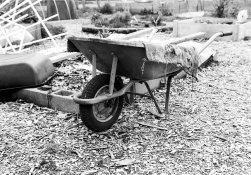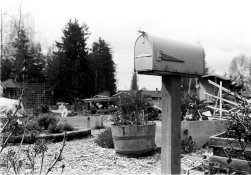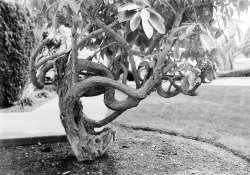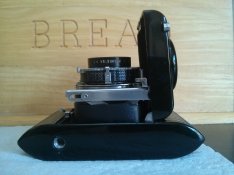Unfortunately, I do not have the original bellows any longer, and I cannot find my notes. However, I do have the dimensions for the new bellows sent to me by Custom Bellows, and they should be close enough, as they are custom made reproductions of the original bellows that I sent them. The bellows are a pleated design with truncated corners. There are 6 pleats on the short edge and 5 pleats on the long edge. The extended length is 1.450" and the compacted length is 0.315".
Small End Dimensions: 1.450" outside (1.150" inside) X 1.520" outside (1.415" inside)
Large End Dimensions: 1.520" outside (1.250" inside) X 1.850" outside (1.570" inside)
The good news is that I sent my bellows over to the UK, so if you ordered new ones from them, they should have the pattern on file. The ones I received did require some filing/fitting of the frames, so that is something to be aware of.
The primary rangefinder adjustments are done on the external rangefinder arm. There is a knurled ring on the back of lens A in the below photo. Loosening this ring will allow you to shift the lens up and down on the rangefinder arm, which will shift the image in the upper rangefinder patch up and down.
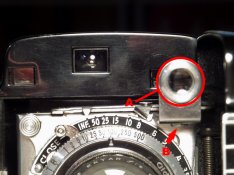
Screw B can be loosened (which is best accomplished by removing the lens and shutter assembly) and then the rangefinder arm can be shifted left and right, which will move the upper rangefinder patch left and right.
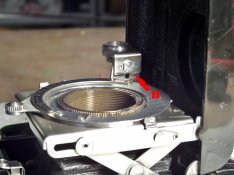
Unless your rangefinder is messed up or the camera has been dropped, you shouldn't have to adjust the rangefinder internally, as there should be enough travel in the external adjustments. However, you probably want to clean the internals, and adjustment may become necessary. Removing the three screws on the back of the viewfinder bump will allow the whole rangefinder assembly to pull out the back. The screws marked in green should not need to be touched as they only deal with the mounting and not the alignment of the prisms. Screw C can be loosened and the end prism tuned which will shift the lower rangefinder patch left and right. Screw D most likely will not need to be touched unless the rangefinder prisms are very dirty, by which loosening it will allow you to remove the double prism, although aligning it after removal is a bit difficult and mostly a trial and error affair.
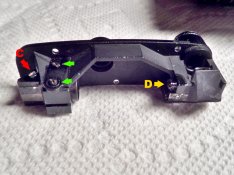
Screw F can be loosened, allowing you to rotate the whole end prism mount up and down, which will move the lower rangefinder patch up and down, but will also cant the lower rangefinder patch clockwise and counterclockwise, so you may need to use it in conjunction with turning the end prism to keep vertical lines vertical.
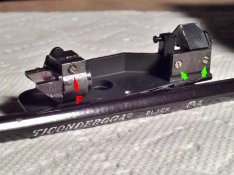
I believe the easiest method to collimate the lens and rangefinder on this camera is to remove the lens/shutter assembly and set the camera at a fixed distance. Then set the distance scale to that distance. Now, adjust the rangefinder so that the vertical and horizontal lines converge properly at that fixed distance. Next, remount the lens, place a piece of ground glass in the film plane. If the image on the film plane is not in focus, remove the locking wedge from the distance scale ring and rotate the inner helical until the image comes into focus, then replace the locking wedge.
As to your lens board alignment, that may be a show stopper. The lens board should be perfectly parallel to the film plane and the lens door should be exactly 90 degrees to the body. There is no adjustment in the body mechanism to correct the issue shown by your picture, and I suspect it is from somebody who did not know better forcing the door closed, probably bending the trellis struts in the process. I don't think there is any fix for this, and it probably won't be possible to get sharp images with the misalignment that is visible in your photo. I know Mike Eckman had a review on his website about a Bantam Special with the same issue as yours and he wasn't able to get sharp images from it.












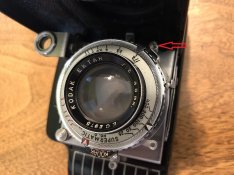
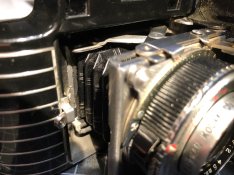
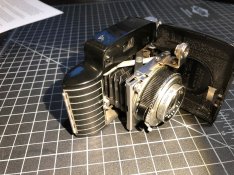
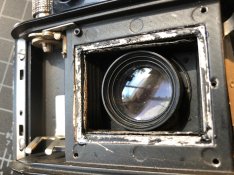
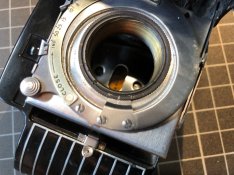

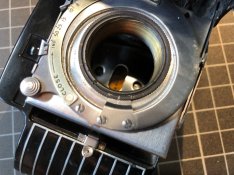
 Airplanes, Windmill, Bike, Barn and Sunset
Airplanes, Windmill, Bike, Barn and Sunset